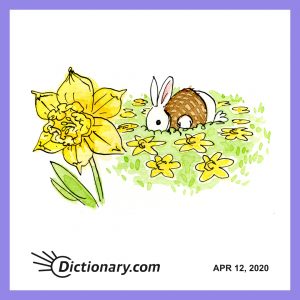Word of the Day
idoneous
adjective
appropriate; fit; suitable; apt.
More about idoneous
The adjective idoneous, “suitable, fit,” is now rare and archaic. It comes straight from Latin idōneous “suitable, appropriate, qualified, able”; it has no reliable Latin etymology. Idoneous has an even rarer derivative noun, idoneousness “fitness, suitability.” Idoneous entered English in the first half of the 17th century; idoneousness is first recorded in English in the first half of the 18th century and was last recorded just over a century later, in the mid-19th.
how is idoneous used?
As far as benefices are concerned no one could be more idoneous, fitting or suitable than Martin, since he is an Anglican clergyman.
What is idoneous cannot be always or necessarily known in advance.
idoneous


quidnunc
noun
a person who is eager to know the latest news and gossip; a gossip or busybody.
More about quidnunc
Quidnunc comes from Latin quid nunc “what now?” Readers of the Roman poet Horace might recognize quidnunc as a quote from one of his humorous and elegant Epistles: “Albius, frank judge of my Epistles, / What now shall I say you are doing …?” Horace’s two lines are a trope for someone who wants to hear all the latest gossip, like Horace, the second person narrator in his Epistle. Quidnunc entered English in the early 18th century.
how is quidnunc used?
It’s hard enough to get on with one’s life without the tittle-tattle of a quidnunc spotlighting your weaknesses.
It is a restaurant with a loyal clientele and, as a quidnunc might put it, a place whose fame has been hushed about for seven years.
quidnunc


daffadowndilly
noun
Chiefly British Dialect.
a daffodil.
More about daffadowndilly
Daffodil has given rise to many, many playful, fanciful variations: daffadowndilly, daffadoondilly, daffadilly, daffodilly, daffydowndilly. The Middle English word is affodil (also affadil and affedil) “asphodel,” the name of several plants, including the daffodil. Affodil comes from French affadille and Medieval Latin affodillus (also asfodillus), from Latin asphodelus, from Greek asphódelos “asphodel.” Spellings with and without initial d– have always existed side-by-side in English, but the initial d– in daffadowndilly (and daffodil) has never been satisfactorily explained. Daffadowndilly entered English in the 16th century.

how is daffadowndilly used?
With your kirtle of green and your gay yellow gown, Daffadowndilly.
Growing in the vale / By the uplands hilly, / Growing straight and frail, / Lady Daffadowndilly.
daffadowndilly





